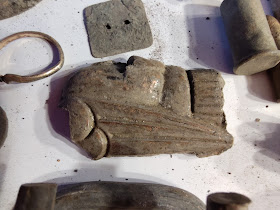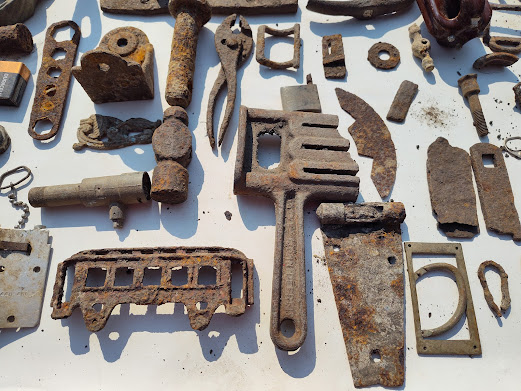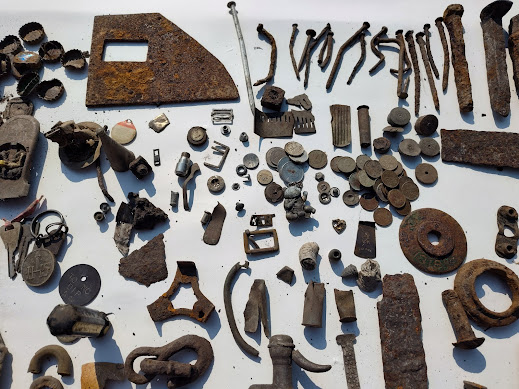After years of swinging a detector and chasing beeps in the dirt, you end up with a lot of stuff. Some of it’s exciting right away, and other things... well, they get tossed in “the bucket.” You know the one—the catch-all container for the rusted, the weird, the unidentifiable. Mine sat untouched in a crawl space for a couple of years until curiosity got the better of me.
Bucket #1
So, I pulled it out, dusted it off, and started the satisfying process of bucket sorting. It’s like a time capsule of past hunts and forgotten excitement.
Axe Head with a Story
One of the first items I pulled out was this old axe head (photo #2). Caked in rust, but still holding its form. The shape and wear suggest it could be early to mid-20th century. What really caught my eye, though, was the faint lettering still visible on one side. It looks like it might say "AMGENT" or something similar, possibly a brand or owner's mark. I haven’t nailed it down yet—if anyone out there recognizes it, let me know! I am thinking something along a Boys Axe, it also has almost a Michigan Axe Pattern look.
Mystery Metal and Curious Finds
Now comes the fun part—the truly random stuff. Shell casings, fishing weights, old buttons, bolts, porcelain fragments, and even what looks like an old razor handle or belt buckle.
Some interesting highlights:
-
Two large shell casings: possibly from an old rifle.
-
A lead fishing sinker with a loop—still intact. Great to throw in the leed pile or reuse it for fishing catfishing.
-
What might be a piece of an old toy wheel or industrial gear, or transmission part (bottom left of the first image).
-
A small button with four holes—likely from clothing, but who knows how old.
-
A strange pair of porcelain shards that might be part of an old dish or decorative tile.
Harmonica reeds.
There’s also what appears to be a vintage car part or machine fitting—definitely heavy-duty. Some of these pieces are pure head-scratchers and may stay that way, but that’s half the fun.
Bucket Sorting, Part 2: The Good Stuff Surfaces
If you’ve ever gone on a serious metal detecting streak, you probably know the "bucket method"—where you toss all your questionable or unknown finds into a bucket with the promise that someday you’ll go through it. Well, this is someday... and welcome to Bucket #2.
Let me tell you right now—this one’s way better.
The first bucket had some interesting odds and ends, sure. But this second one? This is the real treasure. As I started sorting through it, I quickly realized these finds had way more history, mystery, and potential value than the last batch. It's like I saved the best for last without even knowing it.
A super dramatic-looking badge/medallion situation
This one’s wild—it’s got three figures on it, a big ol’ "M", and serious "ancient artifact" vibes. Probably religious because if the "M" and Mary on it. Or maybe it’s from a secret society. Either way, it looks like it belongs in a museum. Or a video game. Plus don't forget the half piece of round sleigh bell. Could have a hallmark on the top but I forgot to look.1918 Canadian Large Cent
This beautiful, ornate coin was part of Canada’s large cent series, minted from 1858 to 1920. Featuring King George V on the obverse and an intricate wreath design on the reverse, this coin marked the end of an era before Canada transitioned to the smaller cent size in 1920.
Value: In circulated condition, it’s worth $2–$10, but a well-preserved piece can go for $50+.
1929 Canadian One Cent
By 1920, Canada had shifted to a smaller one-cent coin, and this 1929 issue is one of the more common dates from the George V era. Despite its age, it’s still frequently found by metal detectorists.
Value: Typically $1–$5, but higher-grade examples can be more desirable.
Silver Coins – A Hidden Treasure?
Among the finds were a few silver-looking coins, 1 pre-1967 Canadian quarters. It will contain 80% silver, making them worth more than just face value. I flipped it over and it was a 1962 quarter!
💰 Value (based on silver content & condition):
-
25-cent (pre-1967) – $4–$6
The "Look Savings Medallion" – A Piece of Forgotten History
This circular find had the words “LOOK” “SAVINGS” and “MEDALLION” inscribed on it. While details are obscured by corrosion, it is:
A vintage advertising or promotional token from Look Magazine, a well-known publication of its time.
-
Look Magazine was a biweekly, general-interest magazine published from 1937 to 1971 in Des Moines, Iowa, with editorial offices in New York City.
-
This medallion could be a promotional tie-in with Look Magazine, which was widely read during the mid-20th century.
Military & Workwear Buttons Found While Metal Detecting
Canadian Military Button (Center of the Image)
This large button, featuring a crown and a maple leaf, is a clear sign it belonged to a Canadian military uniform. It could be from the Canadian Expeditionary Force (CEF) during WWI, or possibly from a later period, such as WWII.
Naval Button with an Anchor
A button featuring an anchor almost definitely came from a naval uniform, likely from the Royal Canadian Navy (RCN) or the merchant navy. These buttons were common during WWI and WWII and symbolize service at sea.
Crowned Eagle Button
This button, with a crowned eagle, suggests a connection to aviation or military forces. It could have belonged to the Royal Canadian Air Force (RCAF) or even a British military uniform, possibly from the WWII era.
Railway Button (Train Design)
Not all buttons are military-related! One of the buttons I found features an engraved train, probably from the Canadian Pacific Railway (CPR) or Canadian National Railway (CNR). Railway workers wore these on their uniforms in the early 1900s, making this a fascinating piece of transportation history.
"PEARBODY" Workwear Button
This button seems to be from Peabody’s, a famous workwear manufacturer from the 19th and early 20th centuries. It likely came from durable denim overalls, work jackets, or factory uniforms—a reminder of Canada’s rich industrial past.
The "Holtum & Welsh" Elynburgh 4-hole button is an interesting find! These buttons are typically associated with workwear or uniforms from the late 19th and early 20th centuries. Holtum & Welsh was a well-known button manufacturer, and buttons like these were used in various industries, particularly for uniforms, military, or industrial workers. The fact that it's a four-hole button points to a practical design used for durability.
Last but not least
Buckles and buttons could have been used for:
Saddles
Harnesses
Backpacks (knapsacks)
Equipment belts or rigging
Other sweet knick knacks like a small gold ring!
While small, buttons can reveal so much about history. Whether from soldiers, sailors, railway workers, or laborers, these artifacts give us a glimpse into the everyday lives of people who lived before us. Next time you find an old button while metal detecting, take a moment to appreciate the story it might tell—you could be holding a piece of history!
Now Remember
Going through buckets was a reminder of why I started metal detecting in the first place: every find, no matter how small or rusted, tells part of a story. Some pieces are relics, some are just junk, but every one of them had to be found. They were part of a journey, a day out, or a surprise signal on an otherwise quiet hunt. I will write out some of the information I find about these items as I research more.
Feel free to reach out if you recognize any of these crusty treasures, have stories of your own, or just want to chat about the thrill of pulling weird old metal from the dirt. I’m always up for swapping tales with fellow diggers, relic hunters, and anyone who’s ever screamed internally after finding yet another bottle cap. May your signals be solid, your finds historic (or at least interesting), and your gear never run out of juice mid-hunt. Happy swinging, eh!
~Windy Digger
UPDATE: May 25th, 2025
I decided to speed up the process and bring all of my bags of goodies outside and place them on the picnic table. Here is what I have sorted so far!
Antique CAST IRON Dent Co. Railroad Floor Train Coach Observation Toy Car 1917
Example of what it actually looked like!The pick in the bottom photo here has a nail in the top that has a large number 29 on it. Railways used numbers on their large nails to track the age of railroad ties. The numbers, often stamped on the heads of the nails, represented the year the tie was laid. So that head would have been from around that time. I think i might give it an electrolysis bath and get a new handle for it and place the nail back in. I want to give that baby a second chance at life!
If you would like to see other items that I have found check out my other Metal Detecting in Manitoba Blog Manitoba Blog
Thank you
~ Windy Digger










































Comments
Post a Comment